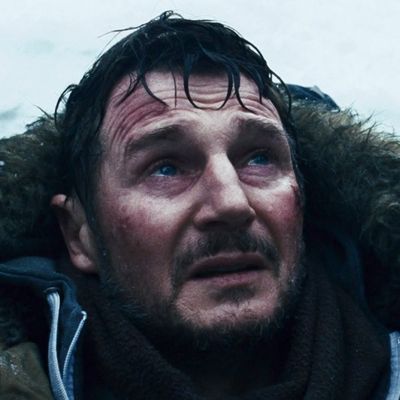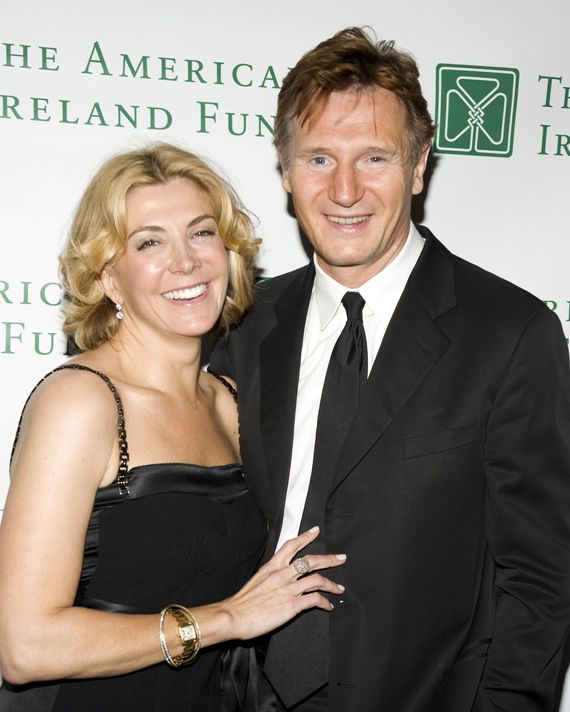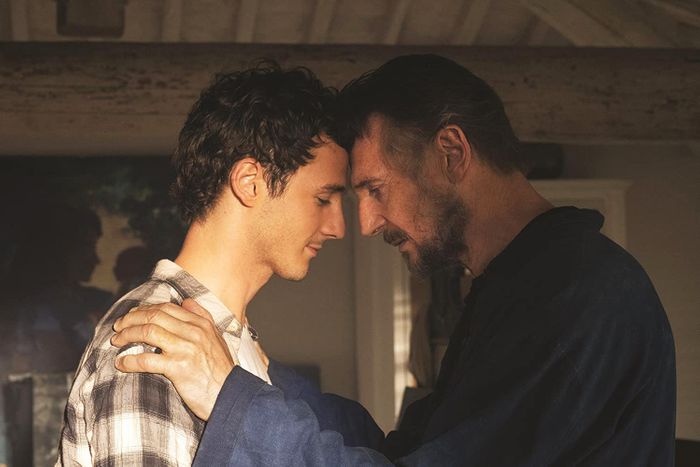
Given his recent output, you could be forgiven for thinking that Made in Italy, Liam Neeson’s latest movie, would be an action thriller about him shooting, strangling, and stabbing his way through Rome or Milan in an attempt to save/avenge a kidnapped/murdered family member. But no, it turns out to be something quite different: a gentle drama. Made in Italy stars Neeson and his actual son, Micheál Richardson, as an estranged father and son who travel to Tuscany to restore and sell a decaying villa that has been in their family for years. The house, we learn, belonged to the Neeson character’s wife, who died in a tragic car accident on a nearby road when the boy was young. They’ve put it on the market because it has too many sad memories. (Spoiler alert: They wind up not selling the house.)
The film’s premise and the fact that Neeson stars alongside his real-life offspring seem to invite a personal reading. In 2009, Neeson’s wife and Micheál’s mother, the acclaimed actress Natasha Richardson, died after a skiing accident during a family vacation in Quebec. Neeson has been quite open over the years about his sorrow. He has spoken tenderly about going into his wife’s hospital room after being told she was brain dead — he had been shooting in Toronto at the time and had flown to be by her side — and talking to her about what had happened, even as she lay in a coma. He was the one who ultimately had to remove her from life support. In a 2014 interview about grief with Anderson Cooper, Neeson mentioned that he still went to Richardson’s grave every week to talk to her. In 2016, he posted a lengthy message on Facebook about her loss. He has admitted to drinking too much in the wake of this tragedy and feeling the pressures of being a single dad.
In the years following Richardson’s passing, Neeson threw himself into his work. And this period coincided with his emergence as an unlikely action phenomenon. In 2008, Neeson had starred in Taken, a surprise hit about a retired CIA agent who tears through Paris after his teenage daughter (Maggie Grace) is abducted by Albanian human traffickers. Nobody expected the French-produced film to make much waves, and it didn’t even get a U.S. release initially. But thanks in part to such meme-worthy elements as Neeson’s quietly menacing phone call with the kidnappers (“What I do have are a very particular set of skills, skills I have acquired over a very long career, skills that make me a nightmare for people like you … I will look for you, I will find you, and I will kill you”), Taken inspired not just two sequels but a whole host of knockoffs, some also starring Neeson. Over the years, other aging actors, like Kevin Costner and Nicolas Cage, have gotten in on the Dadsploitation genre, but Neeson remains the gold standard.
It’s interesting to look at how much things changed between the first Taken, which is a fairly straightforward action-revenge fantasy, and Taken 2, which is more about protective anxiety than rage. In the sequel, Neeson’s Bryan Mills and his ex-wife, Lenore (Famke Janssen), are both kidnapped in Istanbul, this time by gangsters led by the father of a man Mills slaughtered in the first Taken. The story focuses less on watching Mills kick ass and more on his attempts to protect his daughter and save Lenore, who has been grievously wounded. (In the dire and lifeless Taken 3, Lenore is actually killed, with Mills framed for her murder.)
In fact, most of the action films Neeson made during this time play like nightmares about losing his family, each more desperate and twisted than the last. In the thriller Unknown (2011), he plays a doctor visiting Berlin who, after a harrowing car crash, discovers that his existence has been virtually erased: His wife (January Jones) not only pretends not to know him, but she is now married to another man (Aidan Quinn) who has claimed his identity. In Run All Night (2015), Neeson plays a pathetic, alcoholic mob enforcer doing his damnedest to protect his estranged boxer son (Joel Kinnaman) after the latter witnesses a murder. In Non-Stop (2014), he plays a pathetic, alcoholic federal air marshal who gets text messages during a flight from a mysterious individual who threatens to kill a passenger every 20 minutes unless a large ransom is paid; here, Neeson’s character is not protecting his family, but we do learn that the reason for his drinking and generally pitiable nature is the death of his daughter from cancer at a young age. A similarly surreal and sadistic game is played in The Commuter (2018), in which Neeson portrays an ex-cop and recently fired insurance salesman who is forced by a mysterious group to find the one person on a Metro-North train who “doesn’t belong” — and if he doesn’t, he’s told, his family will be killed. Meanwhile, in 2019’s highly self-aware kill-fest Cold Pursuit, he plays a snowplow driver who goes after the drug dealers who murdered his son (again played by Micheál Richardson).
A host of down and dirty but wildly profitable action movies may have once seemed unlikely for the mild-mannered Neeson, whose up-sloping eyebrows and gently melancholy demeanor made him ideal to play holy men, likable romantic leads, and noble historical figures. Decency exuded from him, and that tall frame lent him a certain regal presence (which might be why he once made such a good Zeus). In Steven Spielberg’s Schindler’s List (1993), Neeson stars as a German industrialist who uses his factories to shelter Jews from the Nazis and brings a dashing authority to the role of someone who is part con man, part guardian angel. (It remains his sole Oscar nomination. Spielberg later cast Neeson as the title role in Lincoln, but after years of preparation, the actor suddenly decided he couldn’t do the part.) In Michael Caton-Jones’s Rob Roy (1995), a rare example of a pre-Taken Liam Neeson revenge movie, he is the very picture of quiet rectitude as a 17th-century Scottish outlaw who runs afoul of a local British landlord and has to avenge the deaths of his clansmen and the rape of his wife. And in Bille August’s decidedly imperfect 1998 adaptation of Les Misérables, he makes a perfect Jean Valjean.
Neeson’s own background wasn’t so gentle. He grew up a working-class Catholic kid in a predominantly Protestant town in Northern Ireland during the Troubles. He originally trained for years to be a boxer and even had a very brief career as a soccer player. (He also worked a stint at the Guinness brewery.) In 2019, while promoting Cold Pursuit, Neeson spoke openly and remorsefully about a racist incident from his youth, when he found himself wandering the streets of Dublin looking for a Black man to beat after a friend of his was raped by someone who was Black. The actor recounted the anecdote as an example of how disturbing and relatable a desire for violent revenge could be — it is, after all, the subject of so many of his films — but understandably found himself facing a storm of controversy. Some deemed him unredeemable; others praised his candidness.
In some weird way, though, even talking about the incident was a very Liam Neeson thing to do. A certain sincerity emanates from Neeson, even when he portrays heavies, as in Christopher Nolan’s Batman Begins, where he teaches Christian Bale’s Bruce Wayne pretty much everything he knows, only to eventually be revealed as Ra’s Al Ghul, leader of the League of Shadows and a prime Batman nemesis. In the 1991 thriller Under Suspicion, he plays a down-on-his-luck private eye looking to solve the murder of his wife while also trying to convince the cops that he didn’t do it. Even as the evidence mounts against him, Neeson’s character proclaims his innocence — and we believe him, because, well, he’s Liam Neeson. By the end, we learn that he did, in fact, commit the murder. But we still sort of like the guy.
The first time I myself saw Liam Neeson was in a 1986 episode of Miami Vice, in which he played a reformed Irish Republican Army member turned charismatic (and impossibly hunky) peace activist, who romanced Vice regular Detective Gina Calabrese (Saundra Santiago). By the end, it turned out he actually was still a terrorist and that he was planning to take out the Concorde with a Stinger missile; I still haven’t gotten over the reveal.
But that was then, and this is now. Ever since 2009, Neeson’s range of roles has narrowed, even as his output has skyrocketed. And while the majority of the action films Neeson has made during this period have been of questionable quality (quick rule of thumb: The ones directed by Jaume Collet-Serra tend to be better than those directed by Olivier Megaton), taken together they constitute a uniquely moving journey of bereavement and loss — to the degree that they can sometimes be hard to watch. Action movies often put their heroes’ families in danger to raise their stakes, true, but Neeson’s efforts of the past decade or so take things to nightmarish levels — all the more so because, no matter what role he’s playing, like a true movie star, he is always essentially still playing Liam Neeson. If you squint really hard, it’s not difficult to feel like all these horrible things are happening, over and over again, to the same guy.
And it’s not just the action flicks either. Even the dramas and other smaller films Neeson has made during this time speak palpably to the specter of loss. In Ordinary Love (2019), he and Lesley Manville play an aging couple whose marriage goes into a tailspin when she’s diagnosed with cancer; we learn that they also lost a daughter at a young age. In the fantasy tearjerker A Monster Calls (2018), Neeson voices the role of a massive talking yew tree that helps the child protagonist navigate his mother’s terminal illness. In Steve McQueen’s Widows (2018), about a group of dead criminals’ wives who decide to complete the heist their men were planning, Neeson plays Viola Davis’s supposedly dead master-thief husband; we learn, in a flashback, that their son was killed in a police shooting. (We also learn that Neeson’s character faked his own death so he could run off with another woman; he claims that the loss of his son effectively destroyed his marriage.)
But the work that stands out most prominently from this period is Joe Carnahan’s 2011 masterpiece The Grey, which was marketed (perhaps smartly) as another in Neeson’s string of action flicks, only this time with the star punching wolves. And while the film, about a group of rough-and-tumble oil workers battling both wolves and the elements in the remote Alaskan wilderness after their plane crashes, is almost heart-stoppingly tense, it is more a meditation on death and the silence of God than anything else, with each man trying to find a way to honorably meet his fate in a world that provides them no succor. The Grey opens with Neeson’s character, Ottway, who’s been hired by a petroleum company to clear the work areas of wolves, contemplating suicide by putting a rifle in his mouth. Ottway decides not to kill himself, and his abject despair eventually transforms into a kind of dogged determination to survive. And he turns out to be an ideal guide for these men, not the least when they’re dying — as his soft, kind voice soothes them even as their bodies fail them, quietly telling them it’s okay to let go.
It’s almost as if Ottway’s own despair and closeness to death has given him a kind of clarity about the world. His agony initially appears to be over the end of a relationship. We see, in fleeting flashbacks, a smiling woman in a bed, and we hear the words of a letter he’s written to her: “There’s not a second that goes by when I’m not thinking of you in some way. I want to see your face. Feel your hands in mine. Feel you against me. But I know that will never be. You left me, and I can’t get you back.” At the very end, after everyone has died and Ottway is left alone to fight the wolves, we realize that this was his wife and that he had to sit and watch as she died of a terminal illness. Watching a man who was consumed by grief, thinking back to his wife’s death, deciding one last time to fight for his survival, it’s hard not to think about Neeson’s own emotional journey during this time.
There’s more to Ottway than just grief, however; his loss has curdled into a sense of overwhelming shame. In the opening scenes, we understand that not only can he not bear to live, but he doesn’t feel he deserves to be on this Earth either. The Grey is about death, true, but it is also about a crisis of manhood. Each of these roughnecks, it seems, has someone they love either back home or in their memories: a wife, a daughter, a dead sister. Here, at the far edges of the world, left alone with their thoughts and their mortality, preyed upon by a pack of wolves led by an alpha, each man’s bluster fades away as he has to make peace with his own helplessness.
Take another look at the action films Neeson has made over the past decade or so. Like The Grey, they’re not just about loss. They’re about guilt and inadequacy, expressed through humiliation, disgrace, and immense self-loathing. Run All Night, for all its action theatrics, really comes alive when it portrays the ongoing bitterness between Neeson’s character and his boxer son, who wants no part of his aging, drunken assassin father even as the man helps him survive. In Non-Stop, Neeson’s air marshal is so shattered by pain and drink that when he is accused of secretly being the real hijacker, we sort of believe it; his sense of constant failure feeds into everyone’s suspicions of him. In The Commuter, our hero is less of a mess: It opens with a lengthy montage of the solid, happy, middle-class life he and his family have built, but that in turn enhances his desperation when he is fired from his job. Much like in Non-Stop and Taken 3, The Commuter also winds up with Neeson’s character being accused of committing the very crime he’s trying to prevent/avenge — and, as in those films, there’s a degradation to him that suggests a kind of existential culpability. Whereas once we found it impossible not to trust Liam Neeson, now we too have our suspicions. His goodness is still there, perhaps, but it’s a broken one.
The Commuter has a number of references to the 2008 financial crisis, that great cataclysm of the modern middle-class American male. Could that be why this subgenre has proven so resilient over the past decade or so, in an age of runaway financial malfeasance, constant surveillance, ill-defined forever wars, natural disasters, and more? Seen in that light, these films are fantasies about the stripping and reclaiming of individual power in a world where the individual has been rendered powerless, with Neeson as the temporarily emasculated alpha male who must reconnect, possibly for the last time, with who he really is and find a way to save his loved ones.
But he also has to confront his own feelings of remorse. In the climax to Made in Italy, Neeson’s character, a painter, reveals that one of the reasons he never got over the death of his wife was because he should have been in that car instead of her, but he had been too wrapped up in his work. This too is a crucible Neeson’s characters often have to pass: Each film usually has a moment during which he has to fess up to his sad past, his inadequacy, his blame, his shame, you name it. In Made in Italy, it’s only after coming clean about his own guilt that he is able to overcome his grief, reconcile with his son, find love again, and move on. Like all the other movies, it’s a fantasy, but it’s not a bad one to have.




